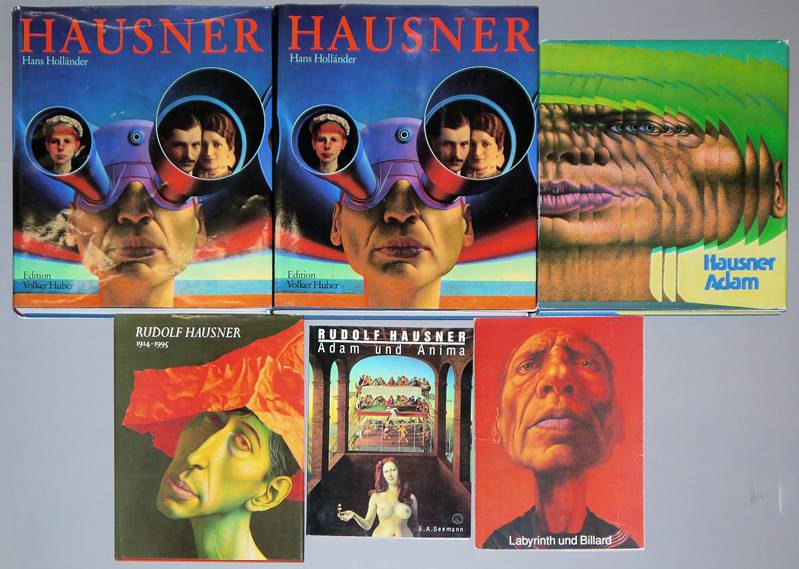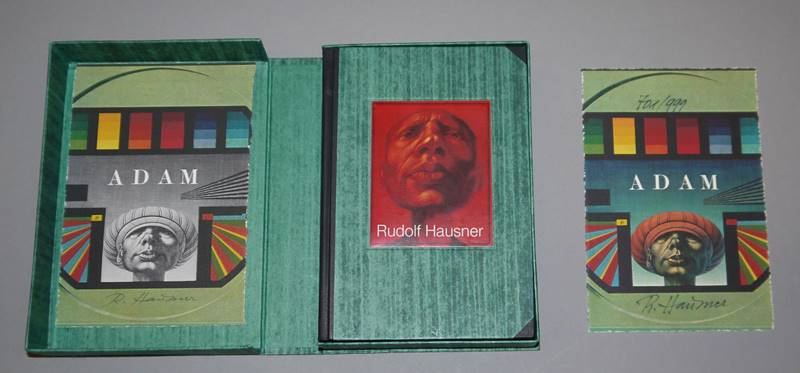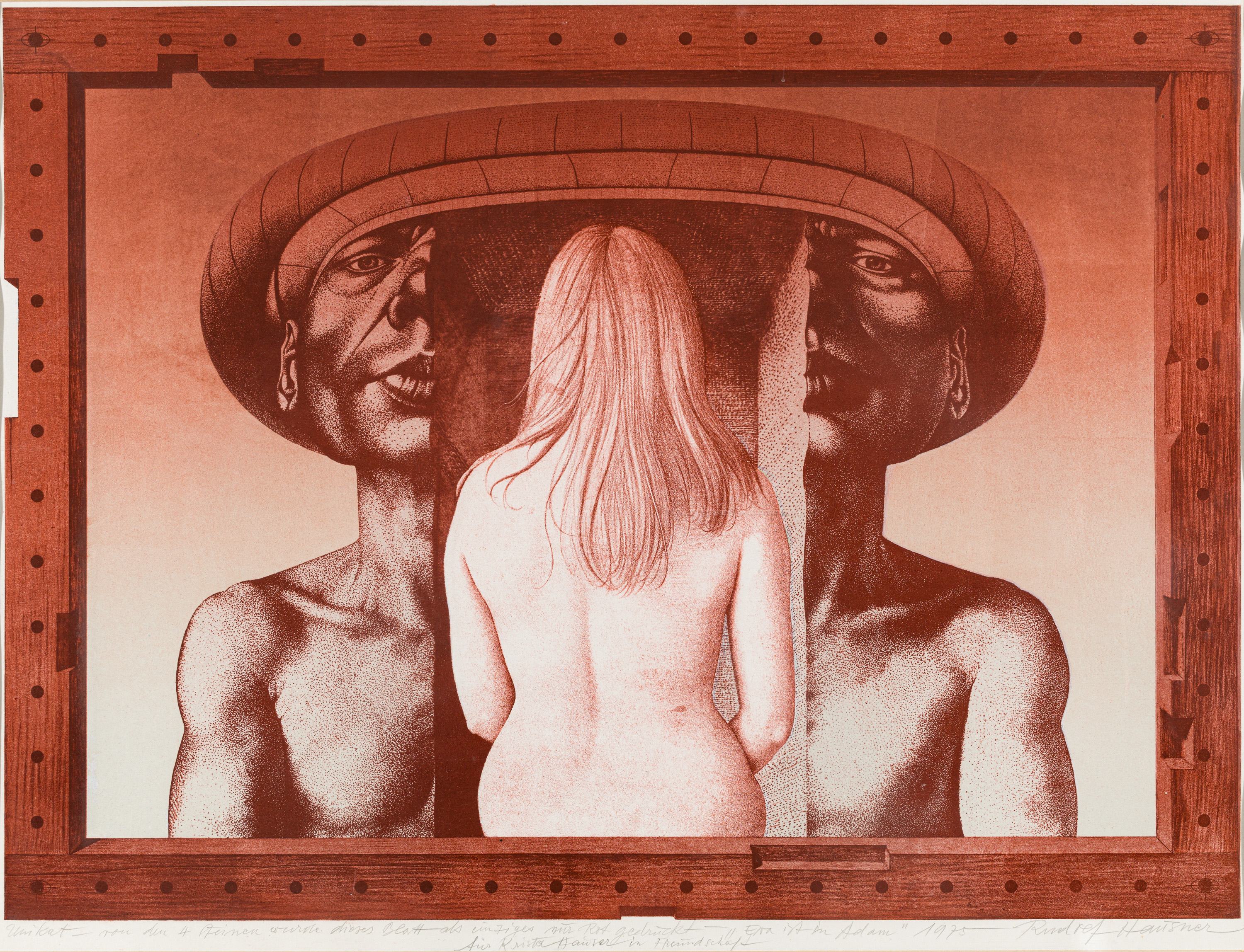(Vienna 1914–1995) “Zwei Kontinente”, signed and dated R. Hausner 61, titled “2 Kontinente” on the reverse, tempera, resin oil on canvas on Novopan panel, 60 x 299 cm, framed Illustrated and registered in: Hans Holländer, Rudolf Hausner Werkmonographie. Volker Huber, 1985, page 259, cat. rais. no. 36 (there dated 1962) and colour ill. on page 126, page 127 detail (in colour), pages 128–130 full-page details in colour, pages 245–246 - Rudolf Hausner’s interpretation of the work “Zwei Kontinente” from 1970 with ill. Wieland Schmied. Rudolf Hausner Werner Hofmann (editor), Verlag Galerie Welz, 1970, cat. rais. page 146, no. 26 (with ill.), full-page colour ill. plates 33, 34, details, plates 35, 36, pages 33, 34 text by Wieland Schmied: Ein Hauptwerk Rudolf Hausners ist sein Bild “Zwei Kontinente”... Published in: Karl Maria Grimme: In der Zone des “Phantastischen” Europa, 7, Europa-Verlag, Bad Reichenhall 1963 Günther Pfeiffer “Wiener Schule” Kunst, 4/5, Verlag Trost, Mainz 1965 Rudolf Hausner Mizue, art magazine, 769, Tokyo 1969 Friedhelm Häring. Labyrinth und Billard, Walltor-Verlag, Gießen 1991, page 24, ill. 7 Exhibited: Surrealismus - phantastische Malerei der Gegenwart, Künstlerhaus Vienna 1962 Salon de Mai, Musée d’Art Moderne, Paris, 1963, Alfred Kubin ed i Pittori fantastici Viennesi, Galleria Il Bilico, Rome 1963 Die Wiener Schule, Kestner Gesellschaft, Hannover, 1965 subsequently – Städtisches Musem, Schloß Morsbroich, Leverkusen Kuratorium, Kulturelles Frankfurt und Kulturamt Frankfurt a. M. Kunstverein Pforzheim, Reuchlinhaus Berliner Festwochen, Senat und Kunstamt Berlin-Charlottenburg, Rathaus Kunstverein Kassel Zentralsparkasse der Gemeinde Wien Rudolf Hausner Künstlerhaus Vienna, 1980, cat. no. 22, two-page colour ill. Rudolf Hausner The Tokyo Shimbun, 1982, full-page colour ill. in the catalogue “I began to paint a landscape. The longer I worked on it, the more clearly two completely different areas developed. One is enclosed by a wall, the other is limitless...” Rudolf Hausner 1970 The city in which Hausner grew up, wearing the sailor suit seen in his pictures, is, needless to say, one of his constantly recurring motifs. The choice, however, is as limited as it is distinctive. It is not the city with its everyday street scenes that is depicted, nor any scenes of the Danube, or the city centre with its Plague Column and St. Stephen’s Cathedral. Vienna is depicted in a different way, namely through the presence of its characteristic places. A park is always present, a structured, geometric French garden, a square formed of straight rows of trees separated from its surroundings. Beginning with his painting „Ark of Odysseus“, this park then reappears in many images as a trapezoid, sloping upwards, manifesting as Schönbrunn Palace or the Belvedere or as one of the many smaller geometrically structured enclaves found among the sea of houses within the city. These images form the backdrops to Sunday afternoon walks, designed to match the sailor suit ... The varied designs of parks and gardens, however, remain the early experience of an oppressive landscape and geometric limitations, green and overgrown yet completely regulated. In the picture entitled “Zwei Kontinente”, the other continent stands in opposition to this, it is wider and larger. The layout of the park only protrudes into it. Included there is the portrait of the boy, his background is of blue sky and his sailor suit is white. As if from another world, he looks out of his frame, belonging to a structure that is not yet his own. Many tiny figures move ant-like, individually or in groups, on the geometrically arranged surfaces. Most of them are strollers who “populate” the park, others form crowds, gathering together. A podium is set up under a parasol and in marching formation, a demonstration with a banner pulls out of the picture in the lower right corner. What the crowd is demonstrating for (or against) is no longer discernible from a distance. The
(Vienna 1914–1995) “Zwei Kontinente”, signed and dated R. Hausner 61, titled “2 Kontinente” on the reverse, tempera, resin oil on canvas on Novopan panel, 60 x 299 cm, framed Illustrated and registered in: Hans Holländer, Rudolf Hausner Werkmonographie. Volker Huber, 1985, page 259, cat. rais. no. 36 (there dated 1962) and colour ill. on page 126, page 127 detail (in colour), pages 128–130 full-page details in colour, pages 245–246 - Rudolf Hausner’s interpretation of the work “Zwei Kontinente” from 1970 with ill. Wieland Schmied. Rudolf Hausner Werner Hofmann (editor), Verlag Galerie Welz, 1970, cat. rais. page 146, no. 26 (with ill.), full-page colour ill. plates 33, 34, details, plates 35, 36, pages 33, 34 text by Wieland Schmied: Ein Hauptwerk Rudolf Hausners ist sein Bild “Zwei Kontinente”... Published in: Karl Maria Grimme: In der Zone des “Phantastischen” Europa, 7, Europa-Verlag, Bad Reichenhall 1963 Günther Pfeiffer “Wiener Schule” Kunst, 4/5, Verlag Trost, Mainz 1965 Rudolf Hausner Mizue, art magazine, 769, Tokyo 1969 Friedhelm Häring. Labyrinth und Billard, Walltor-Verlag, Gießen 1991, page 24, ill. 7 Exhibited: Surrealismus - phantastische Malerei der Gegenwart, Künstlerhaus Vienna 1962 Salon de Mai, Musée d’Art Moderne, Paris, 1963, Alfred Kubin ed i Pittori fantastici Viennesi, Galleria Il Bilico, Rome 1963 Die Wiener Schule, Kestner Gesellschaft, Hannover, 1965 subsequently – Städtisches Musem, Schloß Morsbroich, Leverkusen Kuratorium, Kulturelles Frankfurt und Kulturamt Frankfurt a. M. Kunstverein Pforzheim, Reuchlinhaus Berliner Festwochen, Senat und Kunstamt Berlin-Charlottenburg, Rathaus Kunstverein Kassel Zentralsparkasse der Gemeinde Wien Rudolf Hausner Künstlerhaus Vienna, 1980, cat. no. 22, two-page colour ill. Rudolf Hausner The Tokyo Shimbun, 1982, full-page colour ill. in the catalogue “I began to paint a landscape. The longer I worked on it, the more clearly two completely different areas developed. One is enclosed by a wall, the other is limitless...” Rudolf Hausner 1970 The city in which Hausner grew up, wearing the sailor suit seen in his pictures, is, needless to say, one of his constantly recurring motifs. The choice, however, is as limited as it is distinctive. It is not the city with its everyday street scenes that is depicted, nor any scenes of the Danube, or the city centre with its Plague Column and St. Stephen’s Cathedral. Vienna is depicted in a different way, namely through the presence of its characteristic places. A park is always present, a structured, geometric French garden, a square formed of straight rows of trees separated from its surroundings. Beginning with his painting „Ark of Odysseus“, this park then reappears in many images as a trapezoid, sloping upwards, manifesting as Schönbrunn Palace or the Belvedere or as one of the many smaller geometrically structured enclaves found among the sea of houses within the city. These images form the backdrops to Sunday afternoon walks, designed to match the sailor suit ... The varied designs of parks and gardens, however, remain the early experience of an oppressive landscape and geometric limitations, green and overgrown yet completely regulated. In the picture entitled “Zwei Kontinente”, the other continent stands in opposition to this, it is wider and larger. The layout of the park only protrudes into it. Included there is the portrait of the boy, his background is of blue sky and his sailor suit is white. As if from another world, he looks out of his frame, belonging to a structure that is not yet his own. Many tiny figures move ant-like, individually or in groups, on the geometrically arranged surfaces. Most of them are strollers who “populate” the park, others form crowds, gathering together. A podium is set up under a parasol and in marching formation, a demonstration with a banner pulls out of the picture in the lower right corner. What the crowd is demonstrating for (or against) is no longer discernible from a distance. The















Testen Sie LotSearch und seine Premium-Features 7 Tage - ohne Kosten!
Lassen Sie sich automatisch über neue Objekte in kommenden Auktionen benachrichtigen.
Suchauftrag anlegen